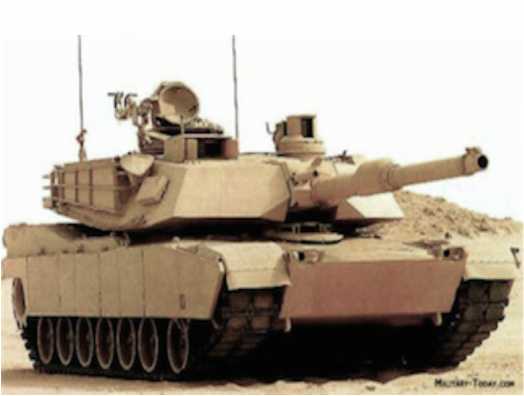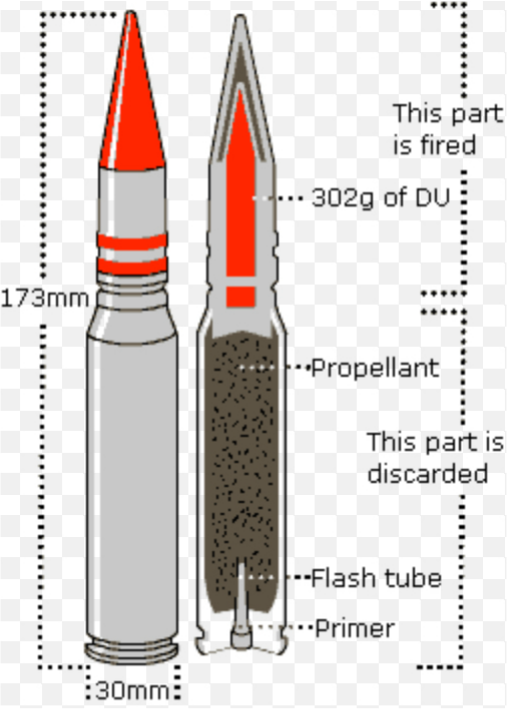|
Copyright R. Zamenhof, 2013.
Introduction
Some time ago, a number of stories surfaced in the media about the U.S. military’s use of depleted uranium as a component of defensive armor plating and armor piercing tank shells, and the potential health risks to civilian and military populations from the use of this technology. What is Depleted Uranium? Depleted uranium is natural uranium, as it is dug out of the ground, but with most of the radioactive uranium-235 isotope removed. The production process is, in fact, exactly the opposite of enriching natural uranium for use as fuel in nuclear reactors or weapons-grade uranium for military applications. Natural uranium is about 99% uranium-238 and 0.7% uranium-235; there are a few other isotopes of uranium present in very small quantities, but these are not relevant to the present discussion. The depletion process further reduces the small amount of uranium-235 present, down to a level of around 0.2%. The resulting material is most commonly called depleted uranium, but is also referred to as DU, Q-metal, or D-3. Uses of Depleted Uranium Civilian DU is used in a number of civilian applications. Alloyed with other metals, such as tungsten or molybdenum, it has an extremely high physical density, nearly double that of lead, as well as having much greater hardness characteristics, almost complete lack of “flow” if installed without external support, and exceptional x- and gamma-ray shielding properties. Civilian uses of DU include counterweights in aircraft and ships’ keels, internal radiation shielding for radiation therapy accelerators, shielding for high x-ray energy industrial radiography equipment, and shielding of containers used to transport radioactive materials. Military Military uses of DU alloys, often called Staballoys, include armor-piercing projectiles and defensive armor plating. DU has the property of being mechanically self-sharpening and chemically self-incendiary when experiencing high mechanical impact pressures, making it a very useful component of shell and missile design. Some late models of the U.S. Abrams tank built after 1998 have DU reinforcement as part of the armor plating in the front of the hull and the front of the turret. DU is also used in some thermonuclear weapons to enhance their destructive effect with a hail of small, extremely heavy, and hard projectiles--somewhat similar in concept to conventional explosive cluster bombs. Health Effects of Depleted Uranium The use of DU for non-thermonuclear weapon military applications is controversial because of concerns about its potential long-term health effects to civilian populations and military personnel. Kidney, brain, liver, heart, and numerous other organs can be damaged by internal exposure to DU aerosol, because in addition to being very slightly radioactive due to the very small residual amount of uranium-235 present, DU is chemically extremely toxic. DU aerosol airborne powder or dust produced following impact and combustion of DU-enhanced munitions can contaminate wide areas around a target impact site and then be inhaled by civilians and military personnel. In 2003, during a three-week period of the war in Iraq, 1,000-2,000 metric tons of DU munitions were used by U.S. forces, mostly in urban environments. It should be emphasized that DU used for civilian applications poses no health risks whatsoever. Controversies Surrounding Toxicity of Depleted Uranium The toxicity of DU is, nevertheless, still a point of controversy. Studies using cultured cells and laboratory rodents indicate the possibility of increased rates of leukemia, as well as genetic, reproductive, and neurological disorders from chronic DU exposure. A 2005 epidemiology review concluded, “The human epidemiological evidence is consistent with increased risk of birth defects in offspring of persons exposed to DU”. In total contrast, however, the World Health Organization has stated that, “No consistent risk of reproductive, developmental, or carcinogenic effects have been reported in humans [following exposure to DU]”. But many scientists have called into question the objectivity of the WHO report. It should be mentioned again that in civilian uses of DU, no known risks are present. Possible Alternatives to Depleted Uranium for Military Applications Even if a replacement could be found for DU in military applications, health concerns would not be alleviated, since possible replacement materials for DU, such as tungsten-cobalt or tungsten-nickel-cobalt alloys, possess extremely carcinogenic properties themselves; far in excess, in fact, of those claimed for DU. So there appears to be little practical alternative to the continued military use of DU. The European Parliament has repeatedly passed resolutions requesting an immediate moratorium on the further use of DU munitions, but France and Britain, the only EU states that are permanent members of the UN Security Council, have consistently rejected calls for such a ban, maintaining that its use continues to be legal and that the putative health risks in humans are “still unsubstantiated”. Unfortunately, the use of DU seems to be a critically important component of U.S. military technology, and it is unlikely that its use will be curtailed in the foreseeable future. We can only hope that a movement toward global peace will eventually retire the use of depleted uranium in military applications. Summary Depleted Uranium (DU) is composed of 99.8% uranium-238 and 0.2% uranium-235. Civilian uses of DU include counterweights in aircraft and ships’ keels, internal radiation shielding for radiation therapy accelerators, shielding for high x-ray energy industrial radiography equipment, and radiation shielding of containers used to transport radioactive materials. Military uses of DU alloys, often called Staballoys, include defensive armor plating and armor-piercing projectiles. Regarding health risks of DU, the World Health Organization has stated that, “No consistent risk of reproductive, developmental, or carcinogenic effects have been reported in humans [following exposure to DU]”. But many scientists have called into question the objectivity of this report. The European Parliament has repeatedly passed resolutions requesting an immediate moratorium on the further use of DU munitions, but France and Britain, the only EU states that are permanent members of the UN Security Council, have consistently rejected calls for such a ban. |
About the Author Archives |
Live Chat Support
×
Connecting

You:
::content::
::agent_name::
::content::
::content::
::content::



 RSS Feed
RSS Feed